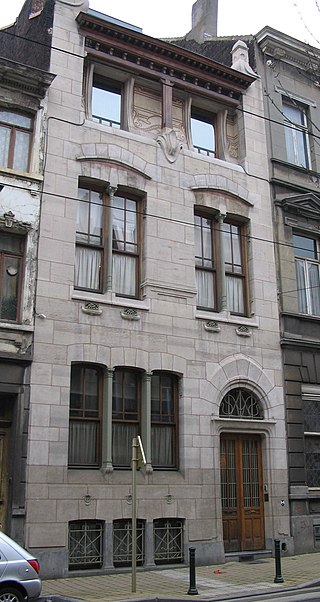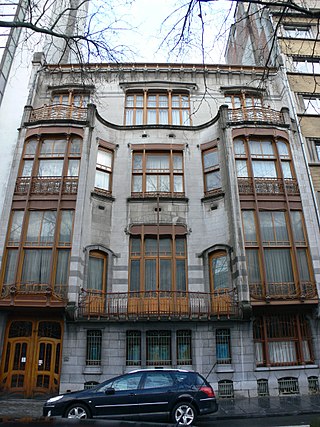
Art Nouveau is an international style of art, architecture, and applied art, especially the decorative arts. It was often inspired by natural forms such as the sinuous curves of plants and flowers. Other characteristics of Art Nouveau were a sense of dynamism and movement, often given by asymmetry or whiplash lines, and the use of modern materials, particularly iron, glass, ceramics and later concrete, to create unusual forms and larger open spaces. It was popular between 1890 and 1910 during the Belle Époque period, and was a reaction against the academicism, eclecticism and historicism of 19th century architecture and decorative art.

Victor Pierre Horta was a Belgian architect and designer, and one of the founders of the Art Nouveau movement. He was a fervent admirer of the French architectural theorist Eugène Viollet-le-Duc and his Hôtel Tassel in Brussels (1892–93), often considered the first Art Nouveau house, is based on the work of Viollet-le-Duc. The curving stylized vegetal forms that Horta used in turn influenced many others, including the French architect Hector Guimard, who used it in the first Art Nouveau apartment building he designed in Paris and in the entrances he designed for the Paris Metro. He is also considered a precursor of modern architecture for his open floor plans and his innovative use of iron, steel and glass.

The City of Brussels is the largest municipality and historical centre of the Brussels-Capital Region, as well as the capital of the Flemish Region and Belgium. The City of Brussels is also the administrative centre of the European Union, as it hosts a number of principal EU institutions in its European Quarter.

Emile Vandervelde was a Belgian socialist politician. Nicknamed "the boss", Vandervelde was a leading figure in the Belgian Labour Party (POB–BWP) and in international socialism.

Paul Hankar was a Belgian architect and furniture designer, and an innovator in the Art Nouveau style.
Gustave Strauven was a Belgian architect of the Art Nouveau style. He created more than 30 buildings, using new technologies and incorporating wrought iron floral motifs.

The Hôtel Tassel is a historic town house in Brussels, Belgium. It was designed by Victor Horta for the scientist and professor Emile Tassel, and built between 1892 and 1893, in Art Nouveau style. It is considered one of the first buildings in that style because of its highly innovative plan and its ground-breaking use of materials and decoration. It is located at 6, rue Paul-Emile Janson/Paul-Emile Jansonstraat, a few steps from the Avenue Louise/Louizalaan.

The Autrique House is a historic town house in Brussels, Belgium. This house, built in 1893, was the first designed by Victor Horta in Art Nouveau style, and represents an essential step in the evolution of the Belgian architect. In many ways, it was an innovative dwelling, although it does not feature the novel spatial composition of the almost contemporary Hôtel Tassel. It is located at 266, chaussée de Haecht/Haachtsesteenweg, in the municipality of Schaerbeek.

The Belgian Labour Party was the first major socialist party in Belgium. Founded in 1885, the party was officially disbanded in 1940 and superseded by the Belgian Socialist Party in 1945.

The Horta Museum is a museum in Brussels, Belgium, dedicated to the life and work of the architect Victor Horta and his time. The museum is housed in Horta's former town house and workshop, built in 1898, in Art Nouveau style. It is located at 23–25, rue Américaine/Amerikaansestraat in the municipality of Saint-Gilles.

The Hôtel Solvay is a large historic town house in Brussels, Belgium. It was designed by Victor Horta for Armand Solvay, the son of the chemist and industrialist Ernest Solvay, and built between 1898 and 1900, in Art Nouveau style. It is located at 224, avenue Louise/Louizalaan, not far from the Hôtel Max Hallet, another remarkable Art Nouveau building by Horta.

The Hôtel van Eetvelde is a historic town house in Brussels, Belgium. It was designed by Victor Horta for Edmond van Eetvelde, administrator of Congo Free State, and built in 1895, in Art Nouveau style. It is located at 4, avenue Palmerston/Palmerstonlaan in the Squares Quarter. An extension, also designed by Horta, was added in 1898.

The Royal Academy of Fine Arts of Brussels is an art school established in Brussels, Belgium. It was founded in 1711. Starting from modest beginnings in a single room in Brussels' Town Hall, it has since 1876 been operating from a former convent and orphanage in the Rue du Midi/Zuidstraat, which was converted by the architect Victor Jamaer. The school has played an important role in training leading local artists.
Le Peuple was a socialist daily newspaper published in Brussels, Belgium. Publication started on 13 December 1885 and ended in March 1998.

The Art Nouveau movement of architecture and design first appeared in Brussels, Belgium, in the early 1890s, and quickly spread to France and to the rest of Europe. It began as a reaction against the formal vocabulary of European academic art, eclecticism and historicism of the 19th century, and was based upon an innovative use of new materials, such as iron and glass, to open larger interior spaces and provide maximum light; curving lines such as the whiplash line; and other designs inspired by plants and other natural forms.

The Art Nouveau movement of architecture and design appeared in Antwerp, Belgium, between roughly 1898 and the start of the First World War in 1914. It was principally practiced by the architects Joseph Bascourt, Jacques De Weerdt, Jules Hofman, Émile Van Averbeke, Émile Thielens, Frans Smet-Verhas as well as August Cols and Alfried Defever. Its principal characteristics in Antwerp buildings include whiplash lines and irregular curves in moldings, ironwork, and incised decoration; gentle arches; colorful ceramic tiles, mosaics, and stained glass; gilded asymmetrical ornament; sgraffito; and keyhole windows and screens.
Events in the year 1893 in Belgium.

The Art Deco movement of architecture and design appeared in Brussels, Belgium, immediately after World War I when the famed architect Victor Horta began designing the Centre for Fine Arts, and continued until the beginning of World War II in 1939. It took its name from the International Exposition of Modern Decorative and Industrial Arts held in Paris in 1925. At the end of World War II, Art Deco in Brussels faded to make way for the modernist and international architectural styles that would mark the postwar period.

The Hôtel Hannon is a historic town house in Brussels, Belgium. Constructed between 1903 and 1904, in Art Nouveau style, for the industrialist Édouard Hannon, it is the only house in that style designed by the architect Jules Brunfaut.

The Saint-Cyr House is a historic town house in Brussels, Belgium. It was designed by the architect Gustave Strauven, and built between 1901 and 1903, in Art Nouveau style. It is Strauven's most important building, and served as a private residence for the painter and decorator George Léonard de Saint-Cyr.
























